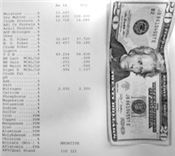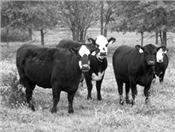Forage Tests And BCS Scores Can Save Money On Cattle
MT. VERNON, MO.
To fully and accurately know what to supplement a cattle herd the owner needs to know the current body condition score of this cattle.
“Producers talking to me about wanting to supplement a herd know their cattle’s age and weights but they are often missing the current body condition score,” said Eldon Cole, livestock specialist with University of Missouri Extension. “This important for any heard and especially for heifers.”
Body condition scores (BCS) have been around for years and is a one to nine evaluation of an animal's fat deposition on its body. A BCS of one indicates the animal is extremely thin and emaciated, virtually a weak, downer type animal. A two BCS is still very thin and weak with ribs and backbone showing.
The one to nine scale progresses to nine which is an extremely fat, obese animal.
“Fortunately, these extremes, one and two and even nine are unusual. Most of the scores I see in this region fall in three to seven scores,” said Cole.
Extension specialists, veterinarians and feed sales representatives like bred heifers to be in the five to six range. A six would not have any ribs nor spine processes visible. There are small fat deposits around the tail head and the brisket will have some fullness.
“A heifer with a BCS of six will more likely rebreed on schedule to maintain a 365-day calving interval than a five which is showing a couple of back ribs. A four will definitely be slow in returning to estrus and she will have a number of ribs visible with her backbone,” said Cole.
A REAL EXAMPLE
One producer with four Angus heifers recently contacted Cole about what to supplement.
“The request from the owner of the four heifers included three forage tests that he had obtained. The three tests probably cost a total of $60,” said Cole.
The tests showed an energy value (total digestible nutrients – TDN) of 56, 55 and 53 percent. The crude protein levels were 16, 15 and 7.7 percent. The two better tests were on alfalfa hay. The other was a grass clover mix.
The owner sent a cattle cube label he provides to the heifers. It was 20 percent crude protein. The feed store said the TDN level was 70 percent. TDN is not a required piece of information on feed labels. For comparison purposes corn, corn gluten feed, dried distillers grains and soybean hulls have respectively TDN values of 88, 80, 92 and 74 percent on a dried basis.
“I checked the nutrient requirements for heifers like this producer reported having,” said Cole. “I figured the BCS at a six since their weight was around 1000 pounds. Their required daily dry matter intake is 20 pounds or about 22 pounds as fed. In the last one-third of pregnancy they require 56 percent TDN and about nine percent crude protein.”
Cole said these numbers indicate that 11 pounds each of this producer’s alfalfa and grass-clover mix should suffice until nearer calving and in early lactation. At that time the daily intake should go up to 26 pounds of dry matter from the hay. Even if they only fed the alfalfa hay at that time, the TDN intake is marginal, and the crude protein is more than adequate according to Cole.
“The cubes, fed at the rate of two pounds per day, should help nearer calving and in the early lactation phase. I stressed to the owner that weather was a big player in nutrient needs,” said Cole.
One of the best safety nets to have during December and January is stockpiled fescue. Providing it is not snow or ice covered, cattle can pick around and find forage that could even match the energy and protein values of the alfalfa hay.
“Whether you have four bred heifers or four hundred cows the place to start on ration checking is with a $20 forage test. It just could save you a big supplement expense,” said Cole. ∆


Pregnant heifers
Photos courtesy MU Extension